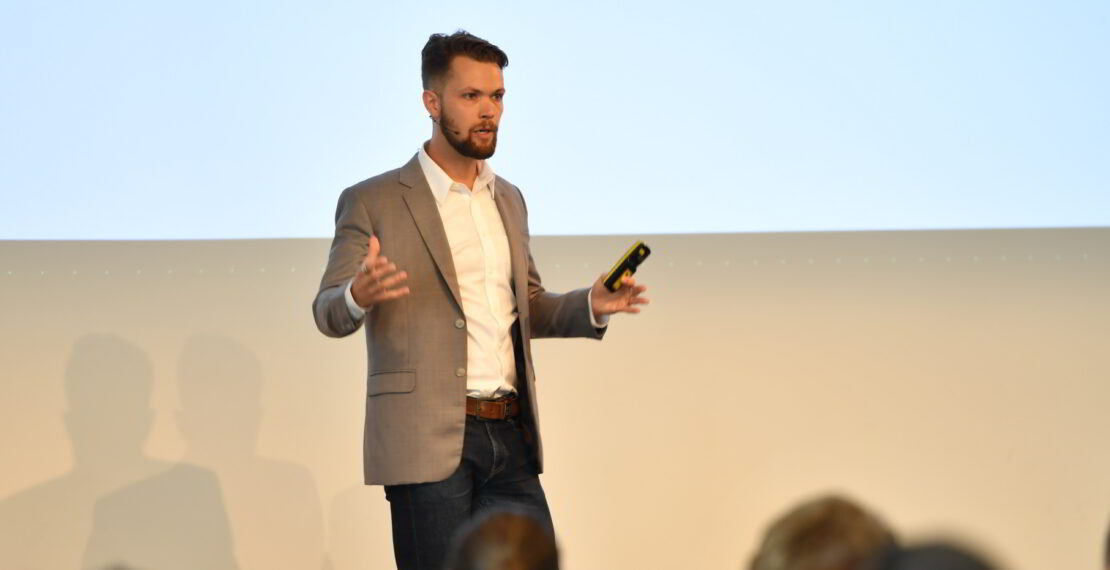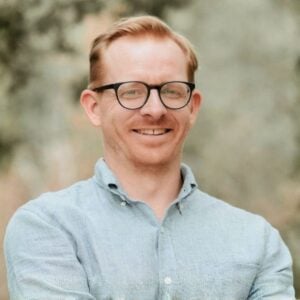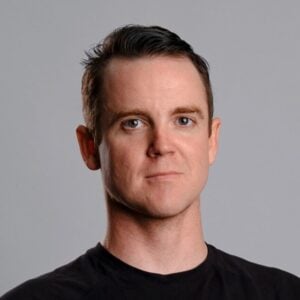Please enjoy this transcript of Paul Austin’s Microdosing Talk at GDI 2018.
Paul Austin, founder of Third Wave, spoke about microdosing and general psychedelic use at a one-day conference on self-optimization. Hosted by GDI, a premier think tank based out of Zurich, Switzerland, the conference was an absolute highlight to present information on psychedelic use.
—
00:07 Paul Austin: So I just wanna start by expressing my gratitude and appreciation for GDI for putting on this event, for this fantastic view that we have here, a beautiful day; for all of you for your attention and coming here. So thank you so much for your presence. It means a lot to me. And also thank you to GDI for allowing me to speak about a topic that many people would consider to be quite controversial, psychedelic substances. And of course, when we talk about the topic of self-optimization, you know, self-optimization has been something to me that’s been very important in my own life. So, this morning, I woke up, I meditated, I went to the sauna briefly, I’ve been fasting. This is something I do quite consistently. And then, of course, I took a microdose of a psychedelic substance because I’m speaking about microdosing so that seemed to make sense. I might as well exhibit the things that I’m going to talk about. So I just wanna start with a question and I know we might have a more reticent audience, but how many of you have tried a psychedelic in the past, by a show of hands? So a higher number than I expected, maybe 30% to 40%. And please keep your hands up if that was a meaningful profound, impactful experience for you, the psychedelic experience. So maybe a few less hands but generally, we can see that when people take psychedelics it tends to be a meaningful, profound experience.
01:46 PA: Now, this was also my experience which is why I’m talking about psychedelics today. Psychedelics have proven to be the tool in my toolkit that have proven tremendously helpful in my own developmental and self-optimization process. I started doing psychedelics when I was about 19 and then got into microdosing a few years ago. Now, what I notice is when I started talking to other people about psychedelics, that there was one main problem. And that’s from a cultural perspective, there seems to be a lack of psychedelic literacy. In other words, because of the second wave and what happened in the counterculture of the ’60s and ’70s, most people don’t have an empirical-based, evidence-based understanding of psychedelic substances. And so that’s been our focus of what we are trying to do at Third Wave is change the cultural conversation around psychedelics by rebranding them so that people can actually start to understand how they can be utilized to improve their quality of life. Because the reason this is a problem is due to this lack of evidence. Most people are missing out on a tremendous opportunity to significantly improve their quality of life through responsible, structured, and intentional psychedelic use. And of course, since we’re talking about self-optimization, this is one of those tools that I think should be considered in everyone’s toolkit going forward.
03:25 PA: So, Julian already mentioned a little bit about the third wave of psychedelics, I’m gonna go into a few more details. The first wave was indigenous use, so that was from the Amazon where they drink something called ayahuasca to ancient India where they drink something called Soma, to the ancient Greeks where even Plato was known to try psychedelics and something called the Eleusinian Mysteries. And then with the second wave, the counterculture of the ’60s and ’70s, which is what traumatized Western culture to this idea of psychedelic substances. Timothy Leary, Ram Dass, Ken Kesey, the Grateful Dead; these are all names that you might recognize from the counterculture of the ’60s and ’70s. And it was earmarked by largely irresponsible, unstructured use of psychedelics that led to a lot of chaos, that led to a lot of downsides. And so the governing administration at the time, the Nixon administration, particularly in the United States, had to crack down. They had to restore order and so, they prohibited all psychedelic substances in the United States, which then happened globally as well. Which brings us now to the third wave. The third wave is about responsible, structured, intentional use of psychedelics where we pay close attention to set and setting like Steven mentioned before. And when we pay close attention to set and setting, then we could facilitate outcomes that are, by and large, positive.
05:00 PA: We can mitigate the downside that can come, the risk that can come with psychedelic use, and instead, really embrace the upside that can come when psychedelics are used within an appropriate context. So what is that appropriate context? So I just wanna give you a brief overview of some of the clinical trials that have been going on with psychedelics so far, and then I’ll transition into microdosing so that you can get a sense of how the concept of microdosing, the idea of microdosing plays a role in this reemergence of psychedelic substances. So the first clinical trial to be aware of is one that was published in 2006 by Roland Griffiths of Johns Hopkins University, where he showed that psychedelics could induce a mystical experience, which we were talking about just before the break, in a consistent reliable manner. And because of that, the people who underwent this mystical experience had one of the most profound impactful experiences of their lives. Now, this study that was done in 2006 laid the entire foundation for a lot of the clinical research that’s been done since then that shows that psychedelics are effective at treating a range of issues from end of life anxiety to alcoholism, PTSD, treatment-resistant depression, OCD, and addiction.
06:28 PA: Now, more recently, two really important phase two trials have been completed. One at NYU and Johns Hopkins that showed that Psilocybin which is the active ingredient in magic mushrooms, again, when utilized within a clinical setting, for 80% of the patients who enrolled in this, there were 90 patients who enrolled, 80% of them showed clinically significant reductions in depression and anxiety related to their terminal illness. Now, what’s even more incredible were the phase two trials that were carried out by an organization called MAPS which showed that when MDMA also commonly called ecstasy, was again administered in a clinical trial, that 69% of people who had treatment-resistant PTSD for an average of 17 years, 69% of them were cured from their PTSD because of the utilization of MDMA. So these are incredible results, and they speak to the difference of psychedelic substances compared to our traditional pharmaceutical maintenance model which is so common today. With our traditional maintenance model, it’s usually, there’s a quote, “A pill for every ill.” Right? Where if you have depression, you’ll take this, you have anxiety, you’ll take this. And because it’s a maintenance model, because it’s largely for profit, then the idea is you get someone on a pill and they have to keep taking it. This is not the case with psychedelics.
08:00 PA: With psychedelics, you take it once or twice at a high dose level and there are significant impacts for the next 12 to 18 months. Instead of being around a product, the pill, it’s around the service of taking care of someone and providing that support afterwards. So where does microdosing fall into this? I like to use a metaphor when I talk about microdosing and that is the metaphor of swimming. So, when you first learned how to swim, you probably didn’t just jump in the deep end right away and try to figure it out. If that was the case, none of you would be here today, you all would have drowned at the age of four or five or six when you learned how to swim. Instead, what probably happened is you went in the shallow end, maybe in an inner tube, you learned how to swim there, you got a sense for it, and then as you felt more and more comfortable, you went out into the deep end where you learned how to navigate a really previously intimidating experience. So microdosing plays a similar role in the utilization of psychedelic substances. When you talk to people who have a pretty good understanding of psychedelics, maybe they’re familiar with the general educational framework, they’ll still say that they’re intimidated to try it because they’re afraid of having a “bad trip”, a really challenging or intimidating experience. So, what microdosing does is it lowers that threshold of risk.
09:31 PA: In short, it allows people to experience the tangible benefits of psychedelic substances at a low-risk profile that allows them to see if they feel comfortable moving to something that can then induce what William James referred to as a mystical experience. So when people are microdosing, what are they experiencing? Well, first of all, microdosing is the consumption of a low dose of a psychedelic. So it’s about a 10th of a regular amount. And people are most commonly doing it with LSD, and Psilocybin mushrooms. And they’re doing it with a specific intention and intention is the most important part because when we set up a protocol for microdosing, the vision is that it’s going to get us somewhere, it’s going to optimize our life to some degree, whether that’s increased creativity, more focus on a work project, better relationships with friends and family, a deeper sense of spirituality. This is the critical component of a microdosing protocol. People do it over the span of maybe eight to 10 weeks. When I microdosed, I did it for seven months. One could say that this might not be so wise, but I’m slightly impulsive and I was kind of just trying something for the first time. And the experience, the benefits that people experience when they were microdosing increased creativity, focused, less social anxiety, mindfulness, these are things that I also experienced while under the influence of my microdosing protocol.
11:11 PA: So why did I stop, right? If there are all these benefits associated with microdosing, why stop? Now, it’s funny, I was having a conversation with Steven for my podcast, I’ve a podcast where I interview people about psychedelics, and he brought up a really good point that when you spend too much time in flow, you can often become impulsive, and you can make decisions that maybe you wouldn’t otherwise have made. And so that’s one downside to be aware of with microdosing is I noticed that when I was microdosing too much, that I didn’t quite have a chance to step back and think about things that was maybe a little bit too impulsive and that led to some decision-making that wasn’t always as rational as I would hope. Now, a couple of other downsides. One, generally, for all psychedelic use, whether microdosing or high doses, anyone who is predisposed to psychosis, so if there’s a family history of psychosis, they should not be trying psychedelic substances because it could induce a schizophrenic break, early-onset schizophrenic break. The other downside to be aware of is we know that with occasional high-dose psychedelic use, that it’s more or less safe as long as set and setting are paid attention to.
12:31 PA: However, we don’t have long-term data on the safety of low dose psychedelic use over a long period of time. So that’s also something that we need more research on in order to really understand the role of microdosing from a long-term basis. Now, I wanna explain this slide above because it is a really interesting slide. And it comes from Imperial College with some Psilocybin fMRI scans that they did. This is an interpretation of the scan itself and this speaks to some of the mechanisms of action that are going on when you’re microdosing.
13:11 PA: Now, one of those mechanisms of action is the activation of the 5-HT2A receptor, which is a serotonin receptor, one of 13 receptors, which is tied to neuroplasticity and adaptability. So when you’re microdosing and microdosing consistently, people are noticing they can learn quicker, that they’re better able to focus, that they’re more in the zone, and that is likely because of the activation of the 5-HT2A receptor. Now, what it’s also doing is it’s creating novel connections in the brain. New connections which lead to increases in creativity, divergent thinking, which again is this ability to take disparate ideas and synthesize them into a new concept. So what you see above is placebo compared to Psilocybin. This is a basic understanding of what’s going on in your brain when you’re microdosing in terms of how it’s creating these novel connections. So we’ve talked a little bit about the past of psychedelics, we’ve talked now about the present, what’s going on with microdosing, what are some of the clinical trials that are happening. Let’s now talk about the future.
14:23 PA: So where are psychedelics going both from a mental health perspective, but also I think more relevant to this audience, from a peak performance, leadership, technical efficacy perspective? These are a couple of anecdotes, which I will come back to if I have time. So it’s my understanding that microdosing will change the cultural perception of psychedelics as I’ve already spoken about and that’s because of anecdotes like this. I’ll just briefly go through these. Sub-doses of 10 to 20 micrograms allow me to increase my focus, open my heart, and achieve breakthrough results while remaining integrated within my routine. I utilize a sub-dose about six days each month. This has been my practice for more than 10 years, and it has facilitated my success working in mainstream and independent media, staff level positions in government, and publishing dozens of pieces of journalistic work. This is Madeline, a professional from Manhattan and this is an excerpt from a book called The Psychedelic Explorer’s Guide, which is written by, what some people may call the godfather of microdosing, Jim Fadiman, who kicked off this whole craze when he was on the Tim Ferriss podcast about three years ago.
15:45 PA: The second quote comes from Jason who is an enrollee in our online microdosing course that we offer at Third Wave, “While I was hopeful that microdosing Psilocybin would have a desirable effect on me, I had not anticipated the effect to be so dramatic. This 10-week period had a profound positive impact on my mental health compared to traditional approaches. Because of microdosing my relationship with depression has changed. It is something I needed to deal with, what we call active coping, instead of trying to escape it through the use of SSRIs, and wishing it would go away, which we refer to as passive coping. Now, this active coping versus passive coping speaks to the efficacy of psychedelics. Psychedelics make you actively cope with trauma or issues to deal with them and fix them. Again, traditional pharmaceuticals tend to just blunt it, and kick the can down the road a little bit further.”
16:45 PA: I wanna get to the future and where this is going. There are two organizations that are good to know about; one is COMPASS Pathways, which is a UK startup that has raised about £7 million so far and is backed by Peter Thiel, the co-founder of PayPal. And COMPASS Pathways is starting clinical trials this quarter where they’re treating over 400 people who have treatment-resistant depression with Psilocybin, the active ingredient in magic mushrooms, in eight countries: Czech Republic, Finland, Germany, the Netherlands, Norway, Portugal, Spain, and the UK. The other organization to be aware of is the Multidisciplinary Association for Psychedelic Studies, which is MAPS. These are the folks that did the phase two trial for MDMA for PTSD. Because of the results they found in those trials, the FDA, the Food and Drug Administration has now granted breakthrough therapy status for MDMA, also called Ecstasy, to treat PTSD, meaning MDMA will be a medically available treatment for PTSD by 2021 in the United States. And that will serve to change our entire model of psychiatric care, as this becomes more understood in terms of its efficacy to treat mental health issues.
18:13 PA: But now, I wanna get a little bit into the peak performance aspect. So leadership. So as Steven talked about a little bit, especially in the Q&A session towards the end, the way that we’re approaching work is changing. With things that are rising like AI and automation, with more and more people who really want to experience life and not just work hard, work hard, work hard, make money, make money, make money, it’s really more about, how can we enjoy of the life that we’ve been given? I think that the way that we also will approach leadership has changed and will start to change. The first one is engagement. The second one is humility. The third one is adaptability. And the fourth one is vision. Humility speaks to this ego dissolution effect of psychedelics that they have where they make you feel interconnected as part of everything. Adaptability, again I talked about the 5-HT2A receptor, adapting to novel situations, microdosing and high doses of psychedelics do this. And vision, these novel connections, the divergent thinking process, being able to take disparate ideas and put them together.
19:28 PA: And as part of my vision, as a leader both at Third Wave, and now as a new project that we’ve rolled out, we’re starting to do this exact thing with professionals, with creatives who wanna utilize psychedelics within a peak performance model to have more creativity, to have breakthroughs in their personal development, to understand innovation and insights. Because in Amsterdam, Psilocybin truffles are legal. You can go into a shop and you can buy them. And so, we’re now facilitating something that’s already been established, a retreat model, and we’re doing it for people who are interested in taking that next step when it comes to professional development.
20:11 PA: So let’s get back to the current moment. The prohibition of psychedelics is one of the greatest failures of scientific and political institutions over the last 50 years, and they remain illegal in almost every country in the world. And as we’ve seen above from the results that we’ve had in clinical trials, this is a travesty for people who both suffer from mental illness, but also for people like us who want to reach higher planes of consciousness, who want to have a mystical experience to really take the next step, whatever that might be.
20:47 PA: And so I’ll leave you with this brief encouragement at the end of the talk today. One is to continue the educational process by going to our website at Third Wave. Please do your best to learn about psychedelic substances because they are going to be increasingly relevant, both in the professional and generally in our global society. The second thing is if you feel comfortable, try a psychedelic for yourself. But if you do it, do it with intention, pay attention to set and setting, and make sure that it’s structured and that you do it in a responsible way. And third, we’ve had the science for over 60 years now, the biggest issue has been cultural stigma. So, if you do try a psychedelic, please talk to other people about it. This is what we’ve been trying to do at Third Wave to change the cultural conversation around psychedelics because we think that these will be incredibly useful tools going forward. Thank you.






